
Home, Auto Repair Library, Auto Parts, Accessories, Tools, Manuals & Books, Car BLOG, Links, Index
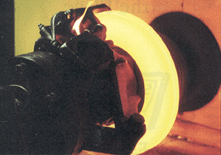


Anybody who works on brakes knows what brake rotors do. They provide a friction surface for the disc brake pads to rub against when the brakes are applied. The friction created by the pads rubbing against the rotor generates heat and brings the vehicle to a stop.
The underlying scientific principle here is that friction converts motion into heat, a LOT of heat! The amount of heat that is generated depends on the speed and weight of the vehicle, and how hard the brakes are applied.
A large, heavy vehicle, like a Chevy Suburban, will obviously generate more heat when braking than a Toyota Echo if both vehicles brake from the same speed. But the little Toyota may produce more heat than the big Suburban if the braking speeds are different, say 60 mph for the Toyota and 20 mph for the Suburban. Speed multiplies the effect of weight and creates momentum (also called "inertia" or "kinetic energy").
Brakes produce friction, and friction produces heat, and this is what brings your vehicle to a stop. But how much heat is actually produced?
Think of heat as a form of energy or power. A more familiar term is "horsepower." We all know what horsepower is, right? It is the stuff that spins the crankshaft when fuel is burned inside an engine. Combustion produces heat, and heat pushes the pistons that make the crankshaft go around. One horsepower is equal to 33,000 pounds-feet of torque per minute, or 550 pounds-feet per second.
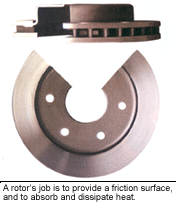
We measure an engines horsepower output by hooking it up to a dyno and seeing how much force it can exert against the resistance created by the dyno. In effect, the dyno acts like a giant brake, so the engines power output is sometimes called its "brake" horsepower output.
By the same token, we can also measure how much horsepower a vehicles brakes must absorb when bringing the vehicle to a stop from a given speed. This is also called "brake" horsepower, but in this case it refers to the brake system, not the engine.
The brake systems on vehicles must be capable of absorbing a lot more horsepower than the engine typically produces because the heat (power) that is generated when braking occurs over a short period of time. Thus, a small car might only need 100 horsepower from the engine to accelerate from zero to a speed of 60 mph. If the driver slams on the brakes and comes to a screeching halt, the brakes have to absorb all the momentum in a much shorter period of time. This multiples the amount of horsepower that must be absorbed, as much as six times depending on the stopping distance. So a panic stop from 60 mph might require the brakes to absorb the equivalent of up to 600 horsepower!
Do not worry about the math because it depends on the speed and mass of the vehicle and the stopping distance. The important point is the brakes often have to absorb a great deal of heat in a very short period of time.
How much heat, you ask? Using more math, units of horsepower can be converted into units of heat energy called BTUs (British Thermal Units). One BTU is the amount of heat it takes to raise one pound of water one degree Fahrenheit.
If you multiply horsepower by the proper conversion factor, you discover that one horsepower generates 42.4 BTUs of heat per minute. If stopping a 4,000 lb. vehicle from 60 mph in roughly 150 feet requires 600 horsepower of force, it is the equivalent of 25,440 BTUs of heat, which is enough heat to raise 15 gallons of water from zero degrees to boiling! No wonder the brakes get so hot.
One thing all brake manufacturers monitor very closely when testing and evaluating pads and rotors is the temperature of the brakes. Every time the brakes are applied, the pads and rotors generate heat that must be absorbed and dissipated. A quick stop from 60 mph can easily push the rotor temperature up 150 or more degrees. Several hard stops in quick succession can push brake temperatures into the 600, 700 or even 800 degree range. Remember, the heavier the vehicle, the more heat it creates when it brakes.
Riding the brakes down a steep mountain road or repeated hard brake applications can produce so much heat the brakes begin to fade.
When brake temperatures get too high, the pads and rotors are no longer able to absorb any more heat and lose their ability to create any additional friction. As the driver presses harder and harder on the brake pedal, he feels less and less response from his overheated brakes. Eventually, he loses his brakes altogether.
All brakes will fade beyond a certain temperature. Semi-metallic linings can usually take more heat than nonasbestos organic or low-met linings. Vented rotors can dissipate heat more rapidly than nonvented solid rotors. Thus, high performance cars and heavier vehicles often have vented rotors and semi-metallic front brake pads to handle high brake temperatures. But if the brakes get hot enough, even the best ones will fade.
Now that we have covered some of the physics of braking and the effects of friction and heat on the brake system, lets look at the rotors role in all of this. As we said earlier, the rotor's job is to provide a friction surface, and to absorb and dissipate heat.
Big rotors can obviously handle more heat than small rotors. But many cars today have downsized rotors to reduce weight. Consequently, the brakes run hotter and require better rotor cooling to keep brake temperatures within safe limits. Many aftermarket performance rotors are drilled, or slotted or both to provide extra cooling and pad venting.
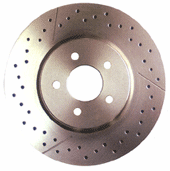
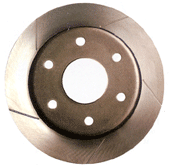
Anybody who works on brakes for a living knows that rotors can cause a lot of brake problems. Uneven rotor wear (which may be due to excessive rotor runout or rotor distortion) often produces variations in thickness that can be felt as pedal pulsations when the brakes are applied. The condition usually worsens as the rotors continue to wear, eventually requiring the rotors to be resurfaced or replaced.
Rotors can also develop hard spots that contribute to pedal pulsations and variations in thickness. Hard spots may be the result of poor quality castings or from excessive heat that causes changes in the metallurgy of the rotors. A sticky caliper or dragging brake may make the rotor run hot and increase the risk of hard spots forming. Hard spots can often be seen as discolored patches on the face of the rotor. Resurfacing the rotor is only a temporary fix because the hard spot usually extends well below the surface and usually returns as a pedal pulsation within a few thousand miles. That is why most brake experts replace rotors that have developed hard spots.
Cracks are another concern with rotors. Cracks can form as a result of poor metallurgy in the rotor (too hard and too brittle because the rotor was allowed to cool too quickly during the casting process), and from excessive heat. Some minor surface cracking is tolerable and can often be removed by resurfacing, but large cracks or deep cracks weaken the rotor and increase the risk of catastrophic failure. So cracked rotors should always be replaced.
The metallurgical properties of a rotor determines its strength, noise, wear and braking characteristics. The casting process must be carefully controlled to produce a high quality rotor. You cannot just dump molten iron into a mold and hope for the best. The rate at which the iron cools in the mold must be closely monitored to achieve the correct tensile strength, hardness and microstructure.
When iron cools, the carbon atoms that are mixed in with it form small flakes of graphite which help dampen and quiet noise. If the iron cools too quickly, the particles of graphite do not have as much time to form and are much smaller in size, which makes for a noisy rotor.
The rate of cooling also affects the hardness of a rotor. If a rotor is too hard, it will increase pad wear and noise. Hard rotors are also more likely to crack from thermal stress. If a rotor is too soft, it will wear too quickly and may wear unevenly increasing the risk of pedal pulsation and runout problems.
The composition of the iron must also be closely controlled during the casting process to keep out impurities that may form "inclusions" and hard spots. One rotor manufacturer says they sample the molten iron every 15 seconds to make sure the composition is correct. The molten metal is also poured through ceramic filters that trap contaminants. Even the sand that is used to make the molds is specially treated to control moisture content. This helps keep the sand in place and prevents core shifts that can affect porosity, dimensional accuracy and balance.
The grade of cast iron that is used in a rotor may even be changed to suit a particular application. One aftermarket rotor manufacturer uses a special grade of "dampened iron" to make replacement rotors for 1997-2002 Chevrolet Malibu and its sister vehicles (Olds Alero, Olds Cutlass and Pontiac Grand Am). In this case, the original OEM rotors turned out to be too noisy so General Motors switched to a dampened grade of iron to cure the problem.
Vehicle manufacturers use a wide variety of different cooling rib configurations in their rotors. They do this to optimize cooling for different vehicle applications. So even though the brakes may appear to be identical on two different models, one may require increased cooling because the vehicle is heavier, has a more powerful engine, has less airflow around the brakes, etc.
Some aftermarket rotor manufacturers use the same rib design and configuration as the OEM rotors, while others do not. Some change the rib design to simplify the casting process or to reduce the number of different rotor SKUs in their product lines.
The OEMs currently use almost 70 different rib configurations in their rotors. Some ribs are straight, some are curved and some are even segmented. Some rotors are directional and some are not. Some rotors have evenly spaced ribs while others do not. Some ribs radiate outward from the center and others go every which way.
One reason why they use so many different rib patterns is to maximize cooling and to reduce harmonics that contribute to brake squeal. Changing the rib design changes the airflow, cooling and noise characteristics of the rotor, which may make things better or worse depending on the application. That is why some aftermarket rotor manufacturers use the same basic design as the original, while others stick with more traditional venting.
One brake manufacturer showed us a cutaway of an offshore "economy" rotor for a particular vehicle that had 32 ribs. The OEM rotor, by comparison, had 37 ribs and provided up to eight percent better cooling than the economy rotor when tested in the laboratory. And because the OEM rib design ran cooler, pad life was 28 percent longer than the economy rotor.
Another aftermarket brake manufacturer showed us test results that proved their rib design improves cooling and makes their rotor three times quieter than a competitive rotor. The recorded sound levels showed noise as high as 85 decibels screaming out of the Brand X economy rotor compared to only 40 to 50 decibels from their own "premium" quality rotor.
A heat dam is often machined into the area between the friction surface and hat on most rotors. The dam is a thinner section of metal that reduces heat transfer from the rotor surface to the hat. This protects the wheel hub and bearings from the heat and also allows the rotor to flex when it gets hot to reduce the risk of warping and cracking.
If a rotor manufacturer cuts corners and eliminates the heat dam, heat can travel more easily to the hub and wheel bearings and increase the risk of bearing failure. The rotor may also be more prone to cracking under high heat conditions.
We will finish up with a few comments about surface finish. Smoother is always better because it affects the coefficient of friction, noise, pad seating, pad break-in and wear. As a rule, most new OEM and quality aftermarket rotors have a finish somewhere between 30 and 60 inches RA (roughness average) with many falling in the 40 to 50 RA range. It is unlikely you are going to improve this any by "cleaning up the rotors" on a bench lathe prior to installing them. In fact, you may make the finish worse if you cut the rotors too quickly or use bits that are dull.
New rotors should always be installed "as is", and indexed on the vehicle with a dial indicator to minimize runout. As a general rule, there should be no more than .003 inches of rotor runout on most cars and trucks, but some cars cannot tolerate any more than .0015 inches of runout. Few technicians take the time to do this, but if they did they had probably see fewer comebacks because of pedal pulsation complaints.
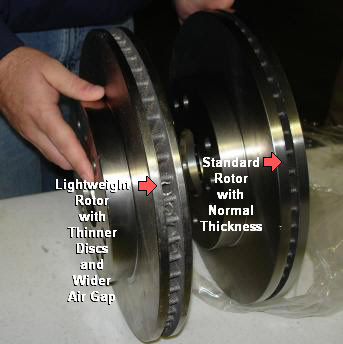
After years of wrangling, the Society of Automotive Engineers (SAE) has developed a brake rotor test standard called J2928 for testing a rotor's ability to withstand cracking caused by repeated thermal cycling. The test requires a rotor to withstand 150 heat cycles without developing dangerous cracks that could result in the structural failure of the rotor on a vehicle.
The new J2928 brake rotor test procedure is a voluntary standard that any brake manufacturer can use to test their rotors. Successfully passing the test means the rotor can safely handle the kind of heat stress commonly encountered when driving without cracking or undergoing undesirable dimensional or structural changes that might result in rotor failure.
To pass this test, rotors must be made of high quality cast iron with consistent metallurgy. Low quality rotors that are made by some offshore manufacturers do not have good metallurgy and may crack or fail when subjected to too much heat. The purpose of the J2928 test is to separate the sheep from the goats, and to help consumers identify quality rotors that can meet the new test standard.
Look for wording that says "Meets J2928 test standards" on the rotor box or packaging as an indication that you are buying a quality rotor that will provide years of safe driving.
New GM-exclusive technology called Ferritic Nitro-Carburizing (FNC) is similar to carburizing used in powertrain gear hardening -- could double the life of brake rotors, from an average life expectancy of 40,000 miles to 80,000 miles.
FNC rotor technology was first introduced on the 2009 Cadillac DTS and Buick Lucerne Super. Currently, it is featured on the Buick LaCrosse and Regal as well as on the Chevrolet Impala, Malibu and Volt. Plans call for it to be featured on more than 80 percent of GM's U.S. vehicles by the 2016 model year.
GM is the only company that has found a way to effectively treat brake rotors with the FNC process and has several patents pending on the technology. Typically, there is a balancing act between performance and service life when designing a brake rotor and brake pad combination. More aggressive brake pad materials offer shorter stopping distances, clean up rotor corrosion quickly and have a longer service life because they tend to wear slower. However, the aggressive pad material often creates more brake noise and dust issues while also wearing the rotor faster.
Application of the FNC technology involves heating the rotors at 560 degrees C for up to 24 hours in a giant oven. Inside the nitrogen-rich atmosphere, nitrogen atoms bond to the surface of the steel rotor, hardening and strengthening the rotor. This hardened layer allows the rotor to wear slower and reduces rotor corrosion.
To slow the oxidation process that leads to rotor corrosion brought on by the environment, the unique FNC process lays down a 10-micron-thick transfer layer, which is equivalent to one-tenth the width of a human hair. The layer is applied across the entire rotor surface as well as the center hat section and inside the central cooling vanes of ventilated rotors.
The FNC treatment creates a strong surface that provides sufficient friction and effective braking performance while providing optimal corrosion protection and wear. This results in reduced rotor thickness variation caused by an uneven buildup of rust on the rotor that occurs over time. In addition, FNC rotors create less brake dust than non-FNC rotors. So along with less rust, wheels that show off wheel hardware are kept looking clean longer.
 Related Brake Articles:
Related Brake Articles: Click Here to See More Carley Automotive Technical Articles
Click Here to See More Carley Automotive Technical Articles